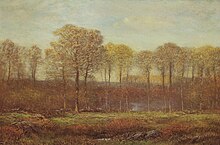Dwight William Tryon
Dwight William Tryon (born August 13, 1849 in Hartford (Connecticut) , † July 1, 1925 in South Dartmouth ) was an American landscape painter in the late 19th and early 20th centuries. His work was influenced by James McNeill Whistler , and he is best known for his landscapes and seascapes painted in the tonalistic style.
Life
youth
Tryon's father died in a gun accident before he was 4 years old and he was raised by his mother on his grandfather's farm in East Hartford. His interest in art developed naturally. As a young man, Tryon worked in a well-known Hartford bookstore and studied art instruction books on display. In his spare time he sketched the surrounding landscape.
In 1870 he sold his first painting. After exhibiting and selling locally, he successfully exhibited at the National Academy of Design in 1873 . Reinforced in his artistic beliefs, Tryon married, quit his job in the bookstore and became a full-time artist. Some of his earliest works from this period are seascapes and harbor views in a luministic style. Soon, however, he turned to the Barbizon School , which was becoming popular among American artists at the time. He may have been influenced by George Inness and Alexander Helwig Wyant .
education
In 1876 Tryon decided to improve his skills through formal study of the arts. He auctioned all of his paintings and, with the help of a benefactor, traveled to France with his wife. He worked in the studio of Jacquesson de la Chevreuse and took classes at the École des Beaux-Arts . He also received instruction from Charles-François Daubigny , Henri Harpignies, and Jean Baptiste-Antoine Guillemet . The Impressionism flourished in France Tryon's, but he was not affected by the new style, but the Barbizon School remained faithful.
Tryon traveled and painted Europe with his wife and met Abbott Thayer and his wife, with whom he befriended. In 1881 he returned to the United States, where he painted landscapes and taught landscape painting. In New York he became friends with the artists Robert Swain Gifford and Thomas Dewing . He became an early member of the Society of American Artists and went on to exhibit paintings at the National Academy of Design . He became a member of the American Watercolor Society and in 1908 the National Institute of Arts and Letters (now the American Academy of Arts and Letters ).
Further work
On the advice of Gifford, Tryon and his wife built a summer home in South Dartmouth in 1887 . Although he spent the winters in New York City, South Dartmouth became his home for the rest of his life. The coastal region met his aesthetic sensibilities and allowed him to pursue his hobby, fishing.
In the late 1880s, Tryon began painting landscapes in what would become his mature and iconic style. Working mostly in oil , his paintings typically contained a group or interrupted row of trees in the middle distance, often colored in autumn, dividing the bright sky, and a foreground of swamp or pastureland. He also went on to paint seascapes in his mature career, often using pastels to represent water, sky, and beach in various weather and light. He exhibited nationally, but preferred the Pennsylvania Academy of the Fine Arts in Philadelphia and the Montross Gallery in New York.
A Detroit industrialist, Charles Lang Freer , first bought a painting by Tryon in 1889 and then became his main patron . Freer bought dozens of Tryon's paintings, including many of his best, and worked closely with him on the interior of his Detroit home. Freer, an important collector of Asian art and the works of James McNeill Whistler , set out to build the Freer Gallery of Art , part of the Smithsonian Institution in Washington, DC , which now houses many of Tryon's works. In 1891 Tryon was elected a full member ( NA ) of the National Academy .
In addition to painting, Tryon taught part-time at Smith College from 1886 to 1923 . He established the Tryon Gallery of Art late in his career. He died of cancer.
Individual evidence
- ↑ nationalacademy.org: Past Academicians "T" / Tryon, Dwight William NA 1891 ( Memento of the original from April 2, 2015 in the Internet Archive ) Info: The archive link was inserted automatically and has not yet been checked. Please check the original and archive link according to the instructions and then remove this notice. (accessed on July 18, 2015)
literature
- Linda Merrill: To Ideal Country. Paintings by Dwight William Tryon in the Freer Gallery of Art. Smithsonian Institution, Washington, DC 1990, ISBN 0-87451-538-6 .
| personal data | |
|---|---|
| SURNAME | Tryon, Dwight William |
| BRIEF DESCRIPTION | American landscape painter |
| DATE OF BIRTH | August 13, 1849 |
| PLACE OF BIRTH | Hartford, Connecticut |
| DATE OF DEATH | July 1, 1925 |
| Place of death | South Dartmouth |


